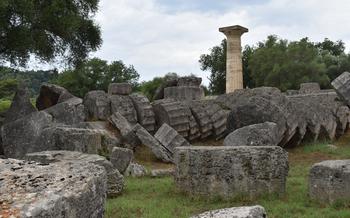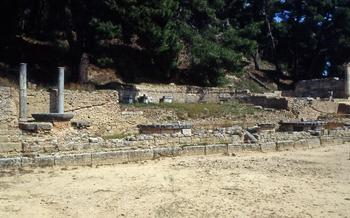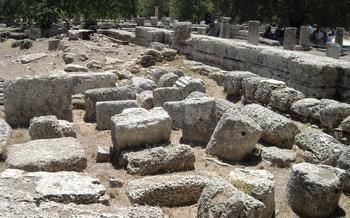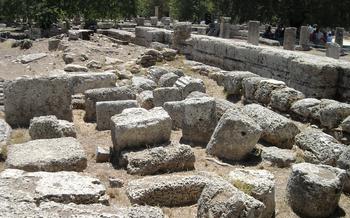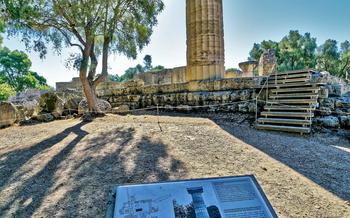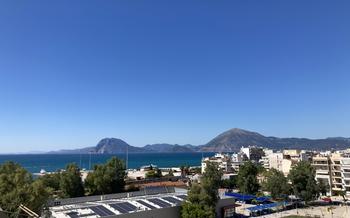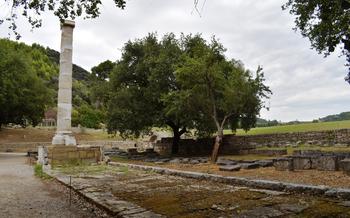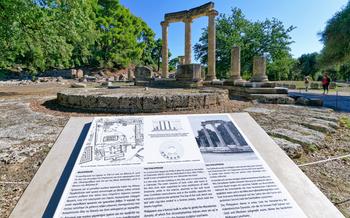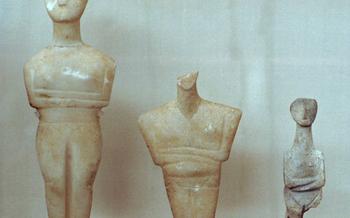
Temple of Hera
- Location and Getting There
- Exploring the Temple Complex
- The Heraia Festival: A Celebration of Hera's Power
- Other Notable Sites in Olympia
- Planning Your Visit: Tips for a Memorable Experience
- Historical Significance of the Temple
- Ancient Rituals and Ceremonies
- Architectural Innovations and Design Features
- Excavations and Discoveries
- Temple's Influence on Art and Culture
Location and Getting There
The Temple of Hera is situated in the sacred precinct of Olympia, approximately 10 kilometers (6 miles) from the modern city of Pyrgos. This ancient sanctuary, dedicated to the worship of the gods, is nestled in the picturesque valley of the Alfeios River, surrounded by lush greenery and rolling hills.
To reach Olympia from major cities in Greece, you can opt for various transportation options. The most convenient way is to take a bus or a train from Athens, which takes around 4 hours. Alternatively, you can drive your own car or rent a vehicle for a more flexible and personalized journey.
If you choose to drive, follow the A7 motorway towards Patras and take the exit for Olympia. The temple is well-signposted from the main road, so you won't have difficulty finding it. Ample parking space is available near the site for your convenience.
Before embarking on your visit, remember to plan your itinerary carefully. Consider the time of year you are traveling, as the weather conditions can greatly impact your experience. The summer months tend to be hot and crowded, while the shoulder seasons (spring and autumn) offer more pleasant temperatures and fewer crowds.
Exploring the Temple Complex
The Temple of Hera stands at the heart of a sprawling complex that was once a bustling center of religious activity. As you approach the temple, you'll be struck by its imposing size and the sheer number of columns that surround it. The temple is surrounded by a colonnade of 6 x 16 columns, with 13 columns on the east and west sides and 6 on the north and south sides. The columns are made of limestone and are topped with Doric capitals. The temple's pediments, or triangular gables, are adorned with sculptures depicting scenes from Greek mythology.
One of the highlights of the complex is the altar, which stands in front of the temple. The altar is made of limestone and is decorated with carvings of animals and plants. It was here that the ancient Greeks made offerings to Hera.
Another highlight of the complex is the colonnades that surround the temple. The colonnades are made up of rows of columns that support the temple's roof. The columns are decorated with intricate carvings, and the roof is made of tiles that are painted with colorful designs. The colonnades provide a shady spot to rest and take in the views of the temple and the surrounding countryside.
The temple complex is also home to a number of statues and sculptures. These statues and sculptures depict a variety of figures, including gods, goddesses, and heroes. Some of the most notable statues and sculptures include the statue of Hera herself, which is located in the cella of the temple, and the statue of Zeus, which is located in the pronaos of the temple.
The Heraia Festival: A Celebration of Hera's Power
The Heraia festival, one of the most significant religious events in ancient Greece, was held every four years in honor of the goddess Hera. It was believed that Hera herself established the festival, demonstrating its importance in ancient Greek culture. During the Heraia, the city of Olympia became a center of religious devotion and celebration, attracting visitors from all over Greece and beyond.
The festival began with a grand procession, led by priestesses carrying sacred objects and statues of Hera. The procession would wind its way through the streets of Olympia, accompanied by music, dancing, and singing. Once at the Temple of Hera, elaborate sacrifices were offered to the goddess, including animals, libations, and other precious gifts.
Athletic competitions were a central part of the Heraia festival, showcasing the physical prowess and competitive spirit of the ancient Greeks. These competitions included footraces, wrestling, boxing, and chariot races. The victors were crowned with wreaths of wild celery and honored with prizes and acclaim.
The Heraia festival was not only a religious and athletic event but also a time for feasting and merriment. People from all walks of life gathered to celebrate, enjoying food, music, and the company of friends and family. The festival provided an opportunity for social interaction, cultural exchange, and the strengthening of community ties.
Other Notable Sites in Olympia
Apart from the Temple of Hera, Olympia is home to a treasure trove of other ancient landmarks that offer a glimpse into the rich history and cultural significance of this sacred site.
-
The Temple of Zeus: This colossal temple, dedicated to the king of the gods, is one of the most iconic structures in Olympia. Its grand ruins, including the remains of its massive columns and pediments, stand as a testament to the architectural prowess of the ancient Greeks.
-
The Olympic Stadium: The birthplace of the Olympic Games, this ancient stadium is a marvel of engineering and a symbol of the athletic spirit that defined ancient Greece. Imagine the roar of the crowd as athletes competed in footraces, wrestling, and other sports in this historic arena.
-
The Archaeological Museum of Olympia: This world-renowned museum houses a vast collection of artifacts unearthed from Olympia, including sculptures, pottery, bronzes, and inscriptions. Among its highlights are the exquisite statue of Hermes by Praxiteles and the pediments from the Temple of Zeus, which depict epic scenes from Greek mythology.
-
The Pelopion: This sanctuary, dedicated to the mythical hero Pelops, is located near the Temple of Hera. It features a circular mound surrounded by a wall and contains the remains of a temple and other structures. The Pelopion played a significant role in the religious rituals and festivals of ancient Olympia.
Planning Your Visit: Tips for a Memorable Experience
To make the most of your visit to the Temple of Hera and Olympia, careful planning is essential. Here are some valuable tips for a memorable experience:
-
Best Time to Visit: The ideal time to visit the Temple of Hera and Olympia is during the shoulder seasons (spring and autumn) when the weather is pleasant, and the crowds are smaller. Avoid the peak summer months (July and August) when temperatures can soar, and tourist numbers swell.
-
Recommended Duration: Dedicate at least half a day to explore the Temple of Hera and the other notable sites in Olympia. This will allow you ample time to wander through the ruins, admire the architectural details, and delve into the history and significance of this ancient sanctuary.
-
Accessibility: The Temple of Hera and the archaeological site of Olympia are wheelchair accessible. Paved paths and ramps have been installed to ensure that visitors with disabilities can navigate the site with ease.
-
Guided Tours and Audio Guides: To enhance your understanding of the temple and its significance, consider joining a guided tour led by knowledgeable experts. Audio guides are also available for a self-guided exploration, providing insightful commentary on the history and highlights of the site.
Historical Significance of the Temple
The Temple of Hera holds immense historical significance as a testament to the evolution of Greek architecture and religious beliefs. Constructed in the Doric style, it represents a crucial stage in the development of Greek temple architecture, showcasing advancements in design and construction techniques. The temple's grandeur and intricate ornamentation served as a model for subsequent Greek temples, influencing not only architectural styles but also the broader development of Greek art and culture.
Furthermore, the Temple of Hera played a pivotal role in shaping ancient Greek religious practices. As the primary sanctuary dedicated to the goddess Hera, the temple attracted worshippers from across the Greek world, who sought her blessings and protection. The temple's rituals and ceremonies were meticulously observed, reflecting the deep devotion and reverence accorded to Hera in ancient Greek society.
The enduring legacy of the Temple of Hera extends beyond its architectural and religious significance. As one of the most iconic landmarks of ancient Greece, the temple has captured the imagination of artists, writers, and historians for centuries. Its ruins continue to inspire awe and wonder, serving as a tangible link to the rich cultural heritage of ancient Greece.
Ancient Rituals and Ceremonies
The Temple of Hera was not merely a place of worship but also a stage for elaborate rituals and ceremonies that honored the goddess and sought her favor. Priests and priestesses played a central role in these ceremonies, performing sacred rites and leading the congregation in prayers and hymns. Offerings of food, drink, and other precious objects were made to Hera, symbolizing the devotion and gratitude of her followers.
Animal sacrifices were also an integral part of the temple's rituals. Bulls, cows, and other animals were slaughtered as offerings to the goddess, their blood spilled on the altar as a symbolic act of appeasement and supplication. The smoke from these sacrifices rose heavenward, carrying the prayers and petitions of the faithful to the divine realm.
Music, dance, and other forms of artistic expression played a significant role in the temple's ceremonies. Musicians performed hymns and songs in honor of Hera, while dancers moved gracefully to the rhythm of the music, their bodies adorned with colorful robes and garlands. These performances were believed to create a sacred atmosphere that facilitated communication between the mortal and divine realms.
Architectural Innovations and Design Features
The Temple of Hera showcases several architectural innovations and design features that were influential in the development of Greek temple architecture. The temple's most striking feature is its use of Doric order columns. These columns, characterized by their simple, fluted shafts and capitals without ornamentation, became the standard for Greek temple architecture. The columns of the Temple of Hera are particularly slender and graceful, contributing to the temple's overall sense of elegance and harmony.
The construction techniques employed in the building of the temple were also innovative for their time. The temple was constructed using a combination of limestone and marble, with the limestone blocks forming the core of the walls and the marble blocks used for the exterior facing. This construction method allowed for the creation of a strong and durable structure while also providing a smooth and aesthetically pleasing surface.
The Temple of Hera also served as a model for the design of later Greek and Roman temples. Its rectangular shape, with a pronaos (porch) and naos (main chamber), became the standard layout for Greek temples. The temple's pediments, which featured sculptures depicting scenes from Greek mythology, also became a common feature of later temples.
The influence of the Temple of Hera on Greek architecture can be seen in temples throughout the ancient world. The Parthenon in Athens, the Temple of Zeus at Olympia, and the Temple of Apollo at Delphi are just a few examples of temples that were inspired by the design and construction of the Temple of Hera.
Excavations and Discoveries
The Temple of Hera has been the subject of extensive archaeological excavations since the late 19th century. These excavations have uncovered a wealth of valuable artifacts and insights into the temple's history and significance.
One of the most significant discoveries was the uncovering of a large number of sculptures and statues that once adorned the temple. These sculptures depict various gods, goddesses, and mythical figures, and provide valuable insights into the religious beliefs and artistic traditions of ancient Greece.
Another important discovery was the uncovering of a series of inscriptions that provide information about the temple's construction, its religious rituals, and the offerings made to Hera. These inscriptions have helped scholars to better understand the role of the temple in ancient Greek society.
The ongoing excavations at the Temple of Hera continue to yield new discoveries that shed light on the temple's history and significance. These discoveries are helping to piece together the story of this ancient monument and its role in the development of Greek culture.
Temple's Influence on Art and Culture
The Temple of Hera at Olympia was not just a religious monument but also a hub of artistic and cultural expression. The temple's grand architecture and intricate sculptures left an indelible mark on the development of Greek art and culture.
-
Sculptures and Reliefs: The temple was adorned with an array of sculptures and reliefs depicting gods, goddesses, and mythical creatures. These masterpieces showcased the exceptional skills of ancient Greek sculptors and contributed to the development of a distinct artistic style that would influence art throughout the Mediterranean region.
-
Influence on Mythology: The Temple of Hera played a significant role in shaping Greek mythology. The stories and legends associated with Hera and her relationship with Zeus, as well as the myths surrounding the birth of Hercules, were often depicted in the temple's sculptures and reliefs. These stories were not only a source of entertainment but also provided moral lessons and insights into the nature of the gods and the world around them.
-
Cultural Identity: The Temple of Hera, as a symbol of the goddess and the Olympic Games, was deeply intertwined with the cultural identity of ancient Greece. The temple represented the values of strength, honor, and athleticism that were central to Greek society. Its presence in Olympia, the birthplace of the Olympics, further reinforced the connection between the temple, the games, and the Greek cultural heritage.
